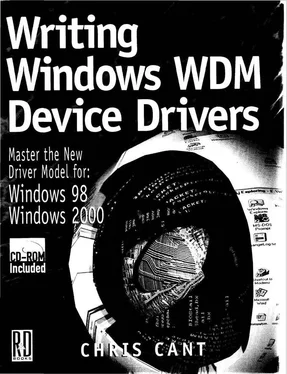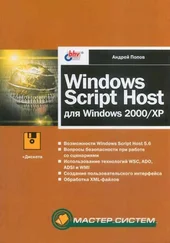Chris Cant - Writing Windows WDM Device Drivers
Здесь есть возможность читать онлайн «Chris Cant - Writing Windows WDM Device Drivers» весь текст электронной книги совершенно бесплатно (целиком полную версию без сокращений). В некоторых случаях можно слушать аудио, скачать через торрент в формате fb2 и присутствует краткое содержание. Город: Lawrence, Kansas 66046, ISBN: , Издательство: R & D Books, Жанр: Программирование, на английском языке. Описание произведения, (предисловие) а так же отзывы посетителей доступны на портале библиотеки ЛибКат.
- Название:Writing Windows WDM Device Drivers
- Автор:
- Издательство:R & D Books
- Жанр:
- Год:неизвестен
- Город:Lawrence, Kansas 66046
- ISBN:0-87930-565-7
- Рейтинг книги:5 / 5. Голосов: 1
-
Избранное:Добавить в избранное
- Отзывы:
-
Ваша оценка:
- 100
- 1
- 2
- 3
- 4
- 5
Writing Windows WDM Device Drivers: краткое содержание, описание и аннотация
Предлагаем к чтению аннотацию, описание, краткое содержание или предисловие (зависит от того, что написал сам автор книги «Writing Windows WDM Device Drivers»). Если вы не нашли необходимую информацию о книге — напишите в комментариях, мы постараемся отыскать её.
Writing Windows WDM Device Drivers — читать онлайн бесплатно полную книгу (весь текст) целиком
Ниже представлен текст книги, разбитый по страницам. Система сохранения места последней прочитанной страницы, позволяет с удобством читать онлайн бесплатно книгу «Writing Windows WDM Device Drivers», без необходимости каждый раз заново искать на чём Вы остановились. Поставьте закладку, и сможете в любой момент перейти на страницу, на которой закончили чтение.
Интервал:
Закладка:
WDM drivers that handle Plug and Play (PnP) IRPs are informed of a device's resources when the Start Device PnP IRP is received. An NT style driver must find what resources each device needs and request use of them.
A significant number of drivers will not need any low-level hardware resources. For example, a USB client driver does not need any hardware resources. The USB bus driver does all the nitty-gritty work of talking to hardware, so only it has to know about the hardware resources that the electronics use. A USB client driver simply has to issue requests to the bus driver. The USB bus driver talks to the hardware to do your job.
WDM drivers spend a lot of time talking to other drivers. A Plug and Play device is in a stack of device objects. It is very common to pass IRPs to the next device down the stack.
Some types of IRP, such as Plug and Play, Power Management, and Windows Management Instrumentation IRPs, are often passed immediately to the next device. Only minimal processing is required in a driver.
In other cases, a driver's main job is achieved by calling the next device down the stack. A USB client driver often calls the USB bus drivers by passing an IRP down the stack. Indeed, a driver often creates new IRPs to do this same job. For example, it is quite common for a Read IRP handler in a USB driver to do its job by issuing many Internal IOCTL IRP requests to the USB bus drivers.
Any device that accesses hardware has to use some mechanism to ensure that different parts of the driver do not access the hardware at the same time. In a multiprocessor system, the Write IRP handler could be running at the same time on two different processors. If they both try to access hardware then very unpredictable results will occur. Similarly, if an interrupt occurs while a Write IRP handler is trying to access hardware, it is quite likely that both tasks will go seriously wrong.
There are two different mechanisms to sort out these sources of conflict. First, Critical section routines are used to ensure that code cannot be interrupted by an interrupt handler, even on another processor.
Second, you should use StartIo routines to serialize the processing of IRPs. Each device object has a built in IRP queue. A driver's dispatch routines insert the IRPs into this device queue. The kernel I/O Manager takes IRPs out of this queue one by one, and passes them to the driver's StartIo routine. The StartIo routine, therefore, processes IRPs serially, ensuring no conflict with other IRP handlers. The StartIo routine will still need to use Critical section routines to avoids conflicts with hardware interrupts.
If you hold an IRP in any sort of queue, you must be prepared to cancel it if the user thread aborts suddenly or it calls the Win32 CancelIo function. You do this by attaching a cancel callback routine to each IRP that you queue. Cancelling can be tricky, as you have to cope if the IRP has been dequeued and is being processed in your StartIo routine.
If the user mode application closes its file handle to your device with overlapped requests outstanding, you must handle the Cleanup IRP. The Cleanup IRP asks you to cancel all IRPs associated with a file handle.
Once you have an address for an I/O Port or memory, it is straightforward to read and write hardware registers and the like. You should not hog the processor for more than 50 microseconds. Consider using system threads or system worker threads, described later, if you need prolonged access to hardware.
Handling interrupts is slightly more complicated. As mentioned earlier, you have to register your Interrupt Service Routine. This must check whether your device caused the interrupt and act on it as soon as possible.
However, this is where is gets complicated. It is not safe for an interrupt handler to call most kernel functions. If an interrupt signals that the last part of a Write request has completed, you will want to tell the I/O Manager that you have completed processing the IRP. However, interrupt handlers cannot do this job. Instead, interrupt handlers must ask for your driver's Deferred Procedure Call (DPC) routine to be run in due course. Your DPC routine can use most kernel functions, thus letting it complete IRPs, etc.
Some drivers must set up Direct Memory Access (DMA) transfers of large amounts of data from devices into memory, or vice versa. DMA is usually done using the shared system DMA controllers. However, some new devices have a built-in bus mastering capability that lets them use DMA themselves. I will not explain how to set up DMA transfers. However, Chapter 24 describes the new DMA routines for the benefit of NT 4 driver writers.
As we all know, hardware is bound to go wrong (unlike our software:-). You should be able predict the common ways in which hardware problems arise: interrupts will not arrive, buffers will overrun, printers will run out paper, and cables will be disconnected. Some of these problems are timing related. You will have to ensure, as far as possible, that your driver is available at all times to process fast I/O events.
Make sure that you check all hardware status bits (e.g., the out-of-paper indication). Further, ensure that a valid error message gets back to the user mode application.
If things go wrong, make sure you implement time-outs and retry the transfer, if appropriate. The I/O Manager provides an easy way to check time-outs with a granularity of one second. However, it is straightforward to implement a timer for smaller intervals. If a transfer still fails after a few retries, you will have to abort the IRP and signal an appropriate error.
If a device's power consumption can be controlled, its driver should support Power Management in W98 and W2000. This applies to both WDM and NT style devices. Power Management conserves battery power in portables and reduces energy consumption and wear in desktop systems. Conversely, some people will have a sleeping or hibernating system on all the time so that it can start up again quickly.
Power Management happens on a system-wide and device-specific scale. The Power Manager can request that the whole system powers down. There are six system power states, including fully on and off, with three sleeping and one hibernating state in between. At a device level, there are four device power states, with two sleeping states in between fully on and off. A device can power itself down even if the rest of the system is running at full speed.
Drivers support Power Management by handling the Power IRP. Quite a few drivers will just pass the Power IRP down the stack of devices. However, your driver will probably be the only one that knows how to change the power usage of your device, so you will have to support the Power IRP correctly.
If possible, a driver should implement the Windows Management Instrumentation (WMI) extensions for WDM. This reports diagnostic and performance information to engineers and management. Drivers make data sets available on request and can fire events when they want. Driver methods can be invoked on demand.
Drivers support WMI by handling the System Control IRP. Again, some drivers will just pass this IRP down the device stack.
You can either use standard WMI data or event blocks or you can define your own new ones in MOF format. These must be compiled and included as a resource in your driver.
The system event log is available in NT and Windows 2000. This is the traditional way of reporting driver problems and should still be supported, if possible. Drivers build an error log entry with an event number and possibly some strings and data. The system event log combines the event number with message strings included in a driver's resources.
Читать дальшеИнтервал:
Закладка:
Похожие книги на «Writing Windows WDM Device Drivers»
Представляем Вашему вниманию похожие книги на «Writing Windows WDM Device Drivers» списком для выбора. Мы отобрали схожую по названию и смыслу литературу в надежде предоставить читателям больше вариантов отыскать новые, интересные, ещё непрочитанные произведения.
Обсуждение, отзывы о книге «Writing Windows WDM Device Drivers» и просто собственные мнения читателей. Оставьте ваши комментарии, напишите, что Вы думаете о произведении, его смысле или главных героях. Укажите что конкретно понравилось, а что нет, и почему Вы так считаете.






